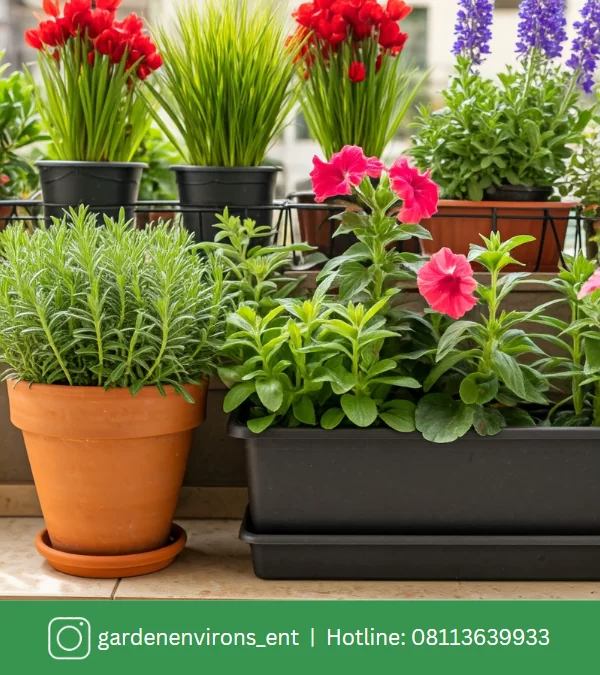Plastic planters offer a cost-effective and long-lasting solution for gardeners at any skill level. Plastic planters are versatile in size, color, and design, making them suitable for both beginners and experienced gardeners. However, not every plant thrives in these pots. Knowing which plants will thrive might help your garden become more bright and healthy.
In this guide, we’ll look at the finest plants for plastic pots and how to make them grow in your environment. Let’s explore the world of container gardening with these hardy, gorgeous plants!
Why Choose Plastic Planters?
Plastic planters are lightweight, making them easy to transport, even when packed with soil. In addition, they are less expensive than other planter materials such as terracotta or ceramic. Another advantage of plastic pot is its longevity; these containers are weatherproof and less prone to split or chip.
However, plastic planters lack the breathability of materials like clay. This means that good drainage and soil aeration are essential. Choosing plants that thrive in these conditions will result in a productive garden.
1. Succulents
Succulents are ideal for plastic pots since they require well-drained soil and minimal watering. These plants retain water in their leaves, making them drought resistant and great for busy gardeners. Popular types like Echeveria, Aloe Vera, and Sedum thrive in plastic containers since they don’t need the breathability of terracotta pots.
Pro Tip: To minimize waterlogging and root rot, use a well-draining potting mix and make sure your plastic planter has appropriate drainage holes.
2. Herbs
Growing herbs in plastic planters is an easy way to bring fresh, aromatic flavors to your kitchen. Herbs such as basil, thyme, parsley, and mint thrive in these containers. They don’t mind the somewhat warmer temperature that plastic pots can provide, especially when put in sunny areas.
Pro tip: Water your herbs on a regular basis, but avoid overwatering. Plastic planters keep moisture for longer than clay pots, so check the soil before watering.
3. Pothos (Devil’s Ivy)
Pothos, with its heart-shaped leaves and easygoing disposition, makes a perfect choice for indoor plastic planters. This low-maintenance plant thrives in low light and needs little watering, making it ideal for beginners or people with hectic schedules. Its cascading vines can be made to grow upwards or down, creating a stunning show.
Pro Tip: Pothos can withstand occasional neglect, but do not allow the soil to dry completely. Regular misting can also help keep humidity levels stable, particularly in dry climes.
4. Ferns
Ferns such as Boston Fern and Maidenhair Fern prefer humid surroundings and thrive in plastic pots, which hold moisture better than porous materials like clay. These plants thrive in indirect sunshine and require regular watering to maintain their rich green leaves.
Pro Tip: To keep the soil from drying up too rapidly, place your plastic planter in a somewhat shaded spot. Mist your ferns frequently to increase humidity.
5. Geraniums
Geraniums are an excellent choice for adding color to plastic planters. These flowering plants thrive in full sunlight and are recognized for their brilliant flowers. These plants prefer well-drained soil, therefore, plastic pots with drainage holes are an ideal choice.
Pro Tip: Deadhead your geraniums to promote new blooms. During hot weather, keep the soil moist but not soggy.
6. Spider Plants
Spider plants are popular among gardeners because of their flexibility and air-purifying properties. These hardy plants thrive in plastic pots, whether indoors or outside. Spider plants thrive in indirect sunlight and do not require frequent watering, making them excellent for people who may forget to water on occasion.
Spider plants grow quickly, so plan to repot them in a larger plastic container or clip their offshoots for propagation.
7. Lavender
Lavender is an aromatic herb that prefers well-drained, slightly sandy soil, making it ideal for plastic pots with enough drainage. This plant thrives in full sunlight and is drought-tolerant once established, making it an excellent choice for anyone wishing to add scent and beauty to their outdoor space.
Pro Tip: Regularly prune lavender to keep it compact and promote new growth. Lavender enjoys dry environments, so avoid overwatering.
8. Snake Plants
Snake plants, commonly known as Sansevieria, are nearly indestructible and thrive in plastic containers. They withstand low light, dry air, and little water, making them one of the easiest plants to maintain. Their towering, erect leaves offer a stunning element to any indoor environment.
Pro Tip: Snake plants tend to dry out between waterings, so let the soil totally dry before watering again.
Tips for Thriving Plants in Plastic Planters
- Ensure Proper Drainage: Make sure your plastic planter includes drainage holes to keep water from gathering at the bottom.
- Use the Right Soil: Plants have various soil requirements. Succulents, for example, require well-drained soil, while ferns enjoy damp mixes.
- Monitor Watering: Plastic planters retain moisture better than porous materials. Check the soil moisture levels before watering to prevent root rot.
- Fertilize Regularly: Plants in pots require regular feeding since nutrients in the soil diminish over time. Use a well-balanced fertilizer, but keep in mind that each plant has unique requirements.
- Position Correctly: Place your planters in areas where your plants will receive the appropriate amount of sunlight. For indoor plants, rotate them occasionally to ensure even growth.
Conclusion
Plastic planters are a good choice for a wide range of plants, as they are both flexible and durable. Whether you’re planting succulents, herbs, or blooming plants, the secret to success is choosing plants that thrive in plastic containers. By following this method, your garden will flourish in no time!
Happy gardening! 🌿

